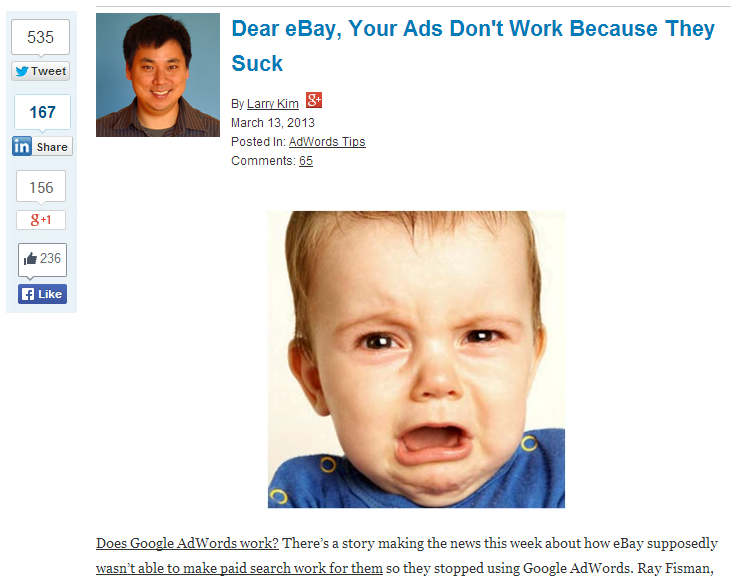
Confession: I’m a content marketing manager who hates most content. It’s all so boring! It’s true in the consumer world – as Choire Sicha, co-founder of The Awl, just said in an interview for The Atlantic:
I opened up my Digg reader the other day, because I was on blogging duty at work, and everything was so duplicative of each other. I was like, yeah, okay, there’s that piece of news filtering through all these different websites, all the same things … no wonder I don’t go to them.
And the same is true in the business-to-business world. Over 90% of B2B companies do content marketing – but 90% of that content marketing is redundant crap, e.g. “5 Ways to Do Blah Blah the Same Way as Everyone Else.” Publishing blog posts like this is basically cargo-cult marketing; it’s trying to make a phone call with a banana phone. Content marketing doesn’t work if nobody cares.
Confession #2: We did some of this ourselves in the past – going through the motions, publishing received wisdom just to get a blog post up. At some point, we decided that wasn’t good enough, and we raised our standards. The results were undeniable: We’ve more than doubled site traffic year over year and grew more than 30% just in the last quarter. Perhaps more exciting, we’ve seen a huge uptick in brand mentions and word-of-mouth referrals.
This shift in our content strategy involved a few moving parts:
- More long-form content – I’d estimate that the length of our average blog post increased by 30-50%. Conventional wisdom used to be that people like shorter content on the web, but we’ve found the opposite to be true: longer, meatier content gets more traffic and better engagement.
- Better content promotion – We started thinking about our promotion strategy before we even created the content. We worked harder to build media/influencer relationships. We used Twitter more for pitching. We leveraged remarketing. (Etc.)
- A commitment to standing out – There’s so much noise out there. Most content is noise. I wanted us to be the signal. We’ve made contrarian opinions part of our brand, and it’s helped us stand out when every other blog is saying the same thing.
In this post, I’ll explain why contrarian content marketing works, share some tips for generating contrarian ideas, and share three examples of contrarian content that hit all of our target “awesomeness” metrics and then some (plus a few caveats at the end).
Why Contrarian Content Does So Well
When you say something counter to received wisdom, people pay attention. It’s the “one of these things is not like the other” principle.
Image via SamahR
This works in every vertical, no matter how boring. (Hey, let’s be honest – PPC is pretty boring in the grand scheme!) Marketers often wonder, how can I create engaging content when I work in this boring industry? The truth is, the people who work in your industry don’t find it boring. You’re trying to hit a nerve with them, not the general population. As long as your content speaks to what matters to them, it won’t be boring.
Controversial ideas have a huge ripple effect because people take an interest – clicking, reading, commenting, and often sharing – whether or not they agree. That’s because it tends to hit people’s emotional triggers, like surprise and anger.
Image via Buffer
Accordingly, contrarian content earns attention and boosts all your engagement metrics, getting more:
- Traffic – Unexpected ideas are click magnets. This includes high return traffic – people come back to read the comments!
- Social shares – When something is making the rounds, a lot of people share even if they don’t read the post. That’s still good for you: the more people who see the link, the more people are exposed to your brand.
- Email shares – “OMG, check this out!”
- Comments – Controversial topics always have higher comment counts, plus the comments are much more compelling than a string of people saying “Nice post.”
- Links – Expect round-up links as well as response articles – people may refute or build on your argument.
As a bonus, since contrarian opinions tend to get your content in front of new audiences that weren’t familiar with you before, it’s often a way to expand your reach, get new email subscribers and blog readers, even trigger a chain of more first actions and conversions on your website.
How to Come Up with Differentiating Ideas
The best way to stand out in a crowded, redundant space is to say something different. But how do you actually come up with those ideas?
Our approach is to monitor trending topics and look for opportunities to inject a strong opinion, using real/internal/branded data and insight wherever possible. The trick is, you have to actually believe what you’re saying. I don’t encourage you to lie or invent contrary opinions just to get attention and links! Your audience will catch on quickly and then you’ll be the victim of Boy Who Cried Wolf Syndrome.
News Scanning Tools
Here are a few ways to stay on top of trending stories:
- Twitter – Follow influencers in your space and spend a little time every day doing a news scan there. It’ll be obvious when everyone is talking about the same thing – no hashtags required.
- News aggregators – In our industry, Inbound.org is a good indicator of what stories are earning attention from your peers. See also Reddit, Y Combinator, etc.
- Email subscriptions – Again, using search marketing as an example, you can subscribe to newsletters like the Search Cap and the Moz Top 10 to see what stories and topics are having an impact.
- Google Alerts – Subscribe to get alerts when topics you cover are getting notice in the news.
- Google Trends – This tool also could surface interesting trends to write about, depending on how niche-y your industry is.
Check out Meg’s list of free content marketing tools for more ideas.
Appoint a News Scan Point Person
Another tactic we’ve employed internally is naming a point person to do a near-daily news scan. This way, everyone in your marketing department or company doesn’t need to divert time and resources to looking for stories to pounce on. Someone on the content team can be responsible for scanning the news and sending out a digest-style email to stakeholders with interesting stories.
The 4 Criteria for a Content-Worthy Controversy
Obviously, you can’t expect to create contrarian content in response to every trending story. It’s unlikely that you’ll disagree with everyone else all the time, and if you did, well, that would look weird, and you should probably hide it. So you’ll need to pick your battles.
How often you can afford to do a big content push depends on your business size and budget, but in general, ask these four questions to decide if a story is worth your time:
- Does the story/topic resonate with people in your industry? Does it have legs?
- Is the story one-sided? Is there apparent consensus?
- Do you disagree with what everyone else is saying? Do you believe there’s more to the story?
- Do you have a unique perspective, something to offer that others can’t or haven’t yet? Can you use internal data to your advantage? (See all the yummy data porn in our post called “Everything You Know About Conversion Rate Optimization Is Wrong.”)
If you answer yes to all four questions (especially #4!), you’ve got an excellent candidate for a contrarian content piece.
Examples: What Contrarian Content Marketing Looks Like
As I mentioned, we’ve seen a lot of success with our contrarian content pieces in the past year or so. In this section I’ll show you a couple of examples of contrarian content projects that got great results for us, including:
a) how we got the idea,
b) how we planned it,
c) how we executed the content,
d) how we promoted it, and
e) the awesome results.
Example 1: “Dear eBay, Your Ads Don’t Work Because They Suck”
The idea for this story came about through our former appointed news scan person. (Hi, Victor Pan!) A story was making the rounds about eBay deciding that paid search wasn’t a worthwhile channel for them. They released a full-on academic study and paper, which got picked up by Harvard Business Review and lots of other spots.
Naturally, the mainstream news media was eating it up: From their perspective, it was kind of a contrarian story: Corporate behemoth does what other corporate behemoths don’t! Plus, they love covering what big brands are doing.
But once all the news outlets were running with the same angle (i.e. “PPC doesn’t work”), that became the standard, boring line. It opened up an opportunity for a new contrarian opinion. This was a golden ticket for us because:
- It was getting mainstream attention – hence, lots of reach.
- It was completely relevant to our blog and business.
It also met that all-important fourth criteria for us – since we’ve been in the PPC space for years, we knew there was more to the story than eBay and the news media was reporting. Namely, that eBay has always been a laughing stock in the paid search community. That’s because their ads suck! They are notorious for overusing broad match, underusing negative keyword filters, and misusing dynamic keyword insertion.
So we quickly wrote up an article (timeliness is key when newsjacking), complete with examples, saying the exact opposite of what eBay’s report was claiming – no, we said, the problem isn’t AdWords, the problem is you.
But we didn’t stop there. We also:
- Pitched it to industry sites like Search Engine Land, Search Engine Journal, and Small Biz Trends.
- Pitched it to the bigger media outlets that ran the original story.
- And generally promoted it like crazy.
It was a big hit, probably not just because of the contrarian angle, but because it was funny too.
Example 2: Toward a Linkless SEO: The SEO Link Is Dying. Here’s What Might Replace It
It’s been an extremely flux-y year so far in search marketing, especially when it comes to linkbuilding. Things really got heated when Matt Cutts announced that guest blogging was dead, and rose to a fever pitch when Google penalized a well-known guest blogging network that need hardly be named.
From my perspective, a lot of people in the search community were reacting the same way, along the lines of “Oh well, we knew this was coming, it’s a shame they made an example of one network, but linkbuilding is here to stay either way.” I basically agreed – on the scale of now and the near future. But I also saw this penalty as different in scope from other spam-fighting measures on Google’s part. Guest-posting had always been considered white-hat in the past – a great way for people to get not just attention, but links too. And suddenly, Google was calling takebacks, saying “Nope, never mind, you can guest-blog, but not for links anymore.” I saw this as an admission that Google has realized links are losing value as a measure of true authority/popularity. Hence, there was an opportunity to zoom out and do some bigger-picture, longer-term thinking.
So I wrote up a kind of “think piece” about how the link is atrophying, plus some predictions about what Google might secretly be cooking up to replace it.
Again, it was a hit – even though, of course, not everyone agreed with it. Remember, as long as you’re really writing stuff you’ve thought about and care about (and it’s not just empty clickbait), contrarian opinions are interesting even to naysayers. For example, AJ Kohn (definitely one of those influencers I’m always trying to influence) tweeted the article even though he vocally disagreed that links are losing value.
In addition to promoting it through all the relevant channels, we also planned on a series of follow-up articles to keep the attention momentum going, including:
- Matt Cutts Confirms That Google Has Tried Search Without Links – An offhand comment in a Webmaster Video lent some credence to my theory that Google is already working on link-free, or less link-dependent, versions of the algo.
- The Future of PageRank: 13 Experts on the Dwindling Value of the Link – I asked industry badasses like Dr. Pete and Rae Hoffman where they thought the algorithm was heading with respect to links. Thanks to all the “real insight from REAL experts” (as Nick Eubanks said <3), this one did even better than the original piece. (Russ Jones left a long comment with his own opposing theory, and his comment ended up getting mentioned in a Whiteboard Friday at Moz.)
- If People Don’t Link to Porn Sites, How Does Google Rank Porn? – Another one inspired by one of Cutts’ Webmaster Videos, and more speculation around how Google handles ranking when links don’t apply or don’t provide enough information to deliver the best results.
The only problem with a series of contrarian articles is that the original naysayers will probably continue to naysay (and potentially get increasingly annoyed). For the most part, so what? However, if you find yourself in a less-than-friendly debate as a result of your content marketing efforts, by all means continue reading.
The Dark Side of Contrarian Content Marketing
Before I bid you adieu, a quick note on the risks involved here. Contrarianism isn’t all rainbows and sunshine. The reason that most people tend to take the same side on an issue is that there’s safety in numbers. Go against popular opinion and you will probably piss some people off.
With that in mind, here’s my advice for taking advantage of the opportunities in contrarian content marketing without creating a PR nightmare:
Watch your tone – You can disagree with people in a civil way. Don’t call anybody stupid. Be assured without being arrogant. Back up your claims.
Respond to disagreement respectfully – If people get vehement or angry in your social streams or your comment field, stay cool in your own responses. Chances are it’s not worth burning bridges over.
Apologize when necessary – When colleagues you respect are genuinely offended, you probably went too far. Get some perspective and issue apologies when and where they’re due. But remember, it’s better to anticipate and prepare for disagreement from the outset, than to bloviate blindly and then have to clean up the mess later.
I don’t expect everyone who reads this post to start acting on it – everyone can’t be contrarian, by definition! But those who do are going to start kicking ass in their industries and creating content that people actually want to read, share, and talk about: a huge win for brand building.
Now go forth and stir the pot.













